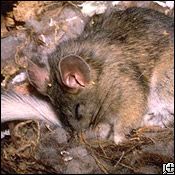Also called packrat, this creature has a habit of stealing shiny objects to add to its den of sticks, bones, and vegetation.
A smaller nest is tucked inside the seven- or nine-foot (2- or 3-m) -diameter den, which may be found on cliffs, rock slides, rocky outcroppings, and in caves and canyons.
Advertisement
Bushy-tailed woodrats eat mainly green plant matter, but also twigs, nuts, and seeds, some of which may be stored in the protective outer layer of the nest for later consumption.
Although this creature is basically terrestrial, it does climb, making use of its tail for balance, and occasionally it builds its nest in trees at heights of up to fifty feet (15 m).
Spotted owls, bobcats, and weasels are just a few of this species' predators.
When alarmed, the woodrat makes a loud drumming sound by beating its hind foot against the ground.
Advertisement
